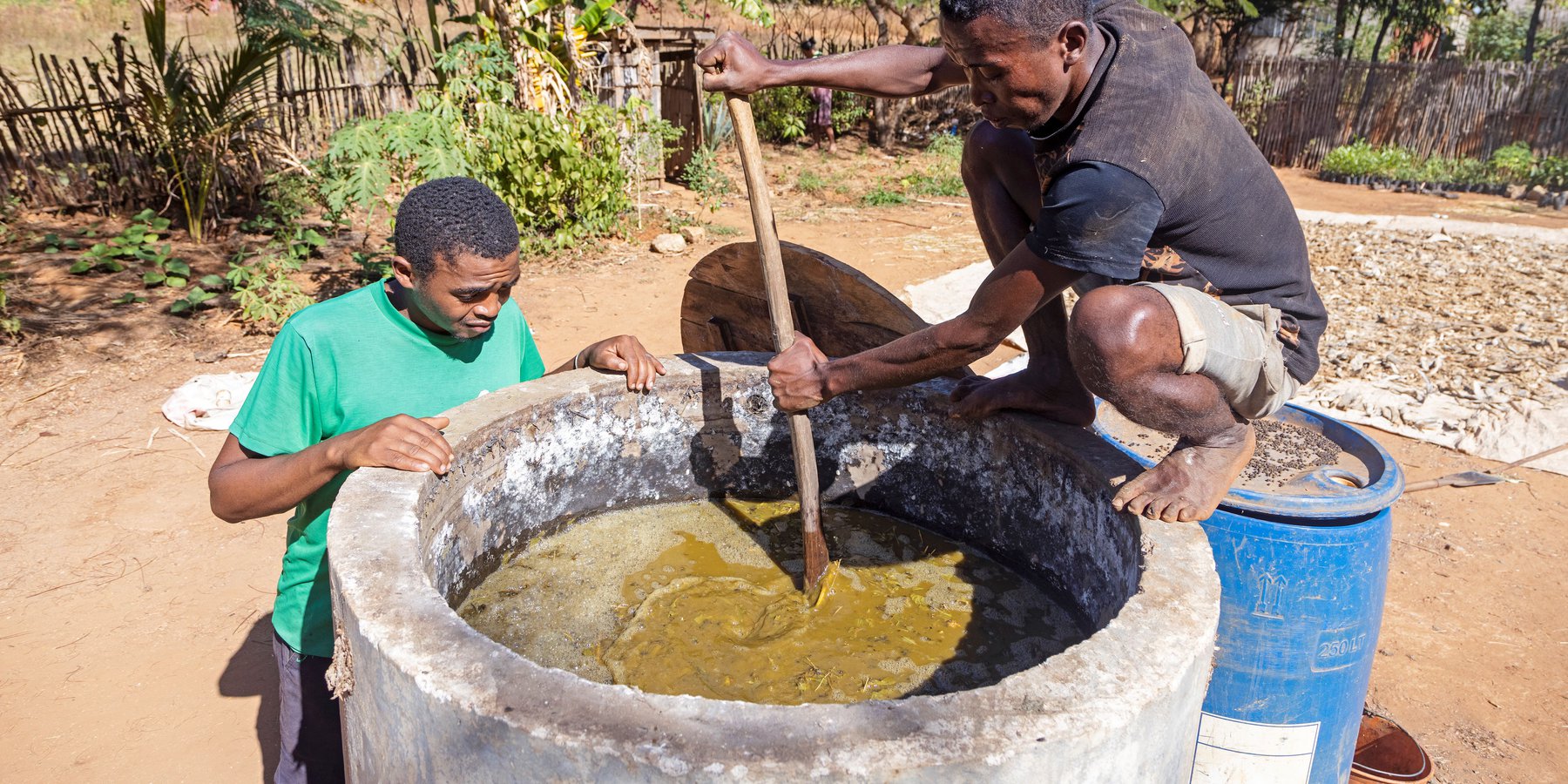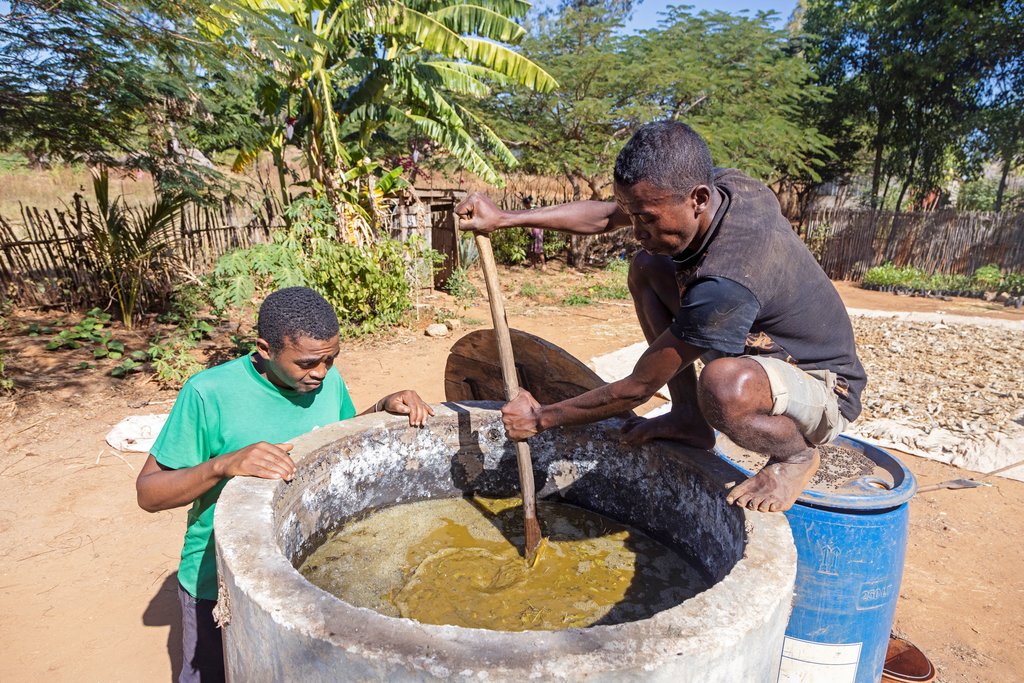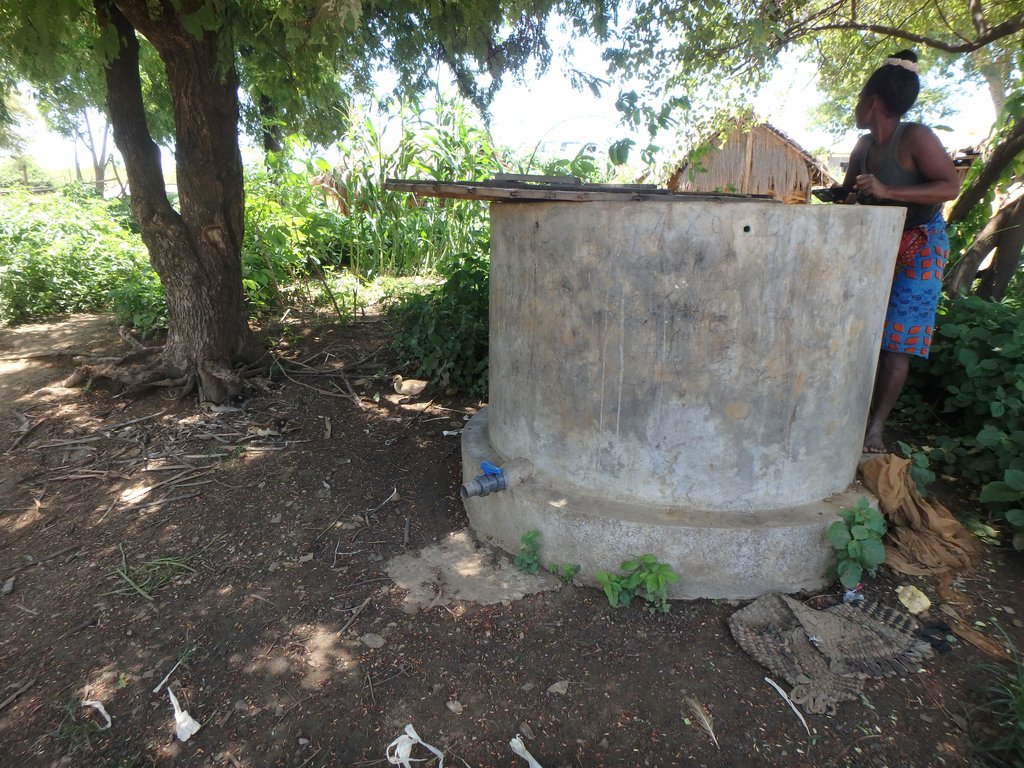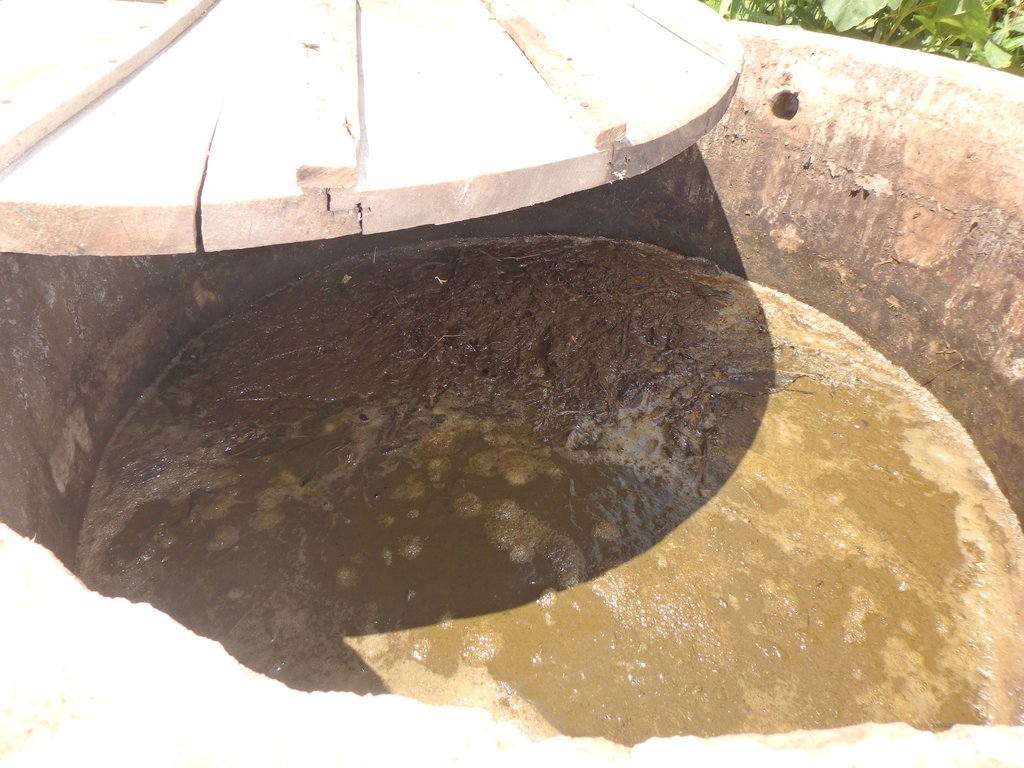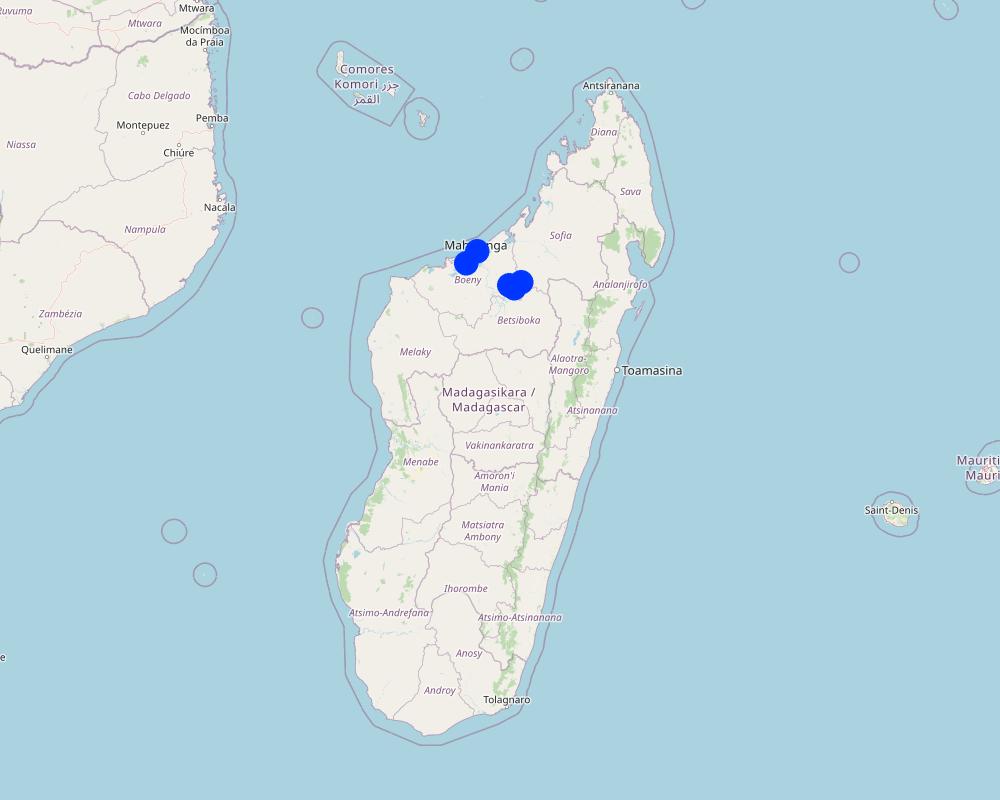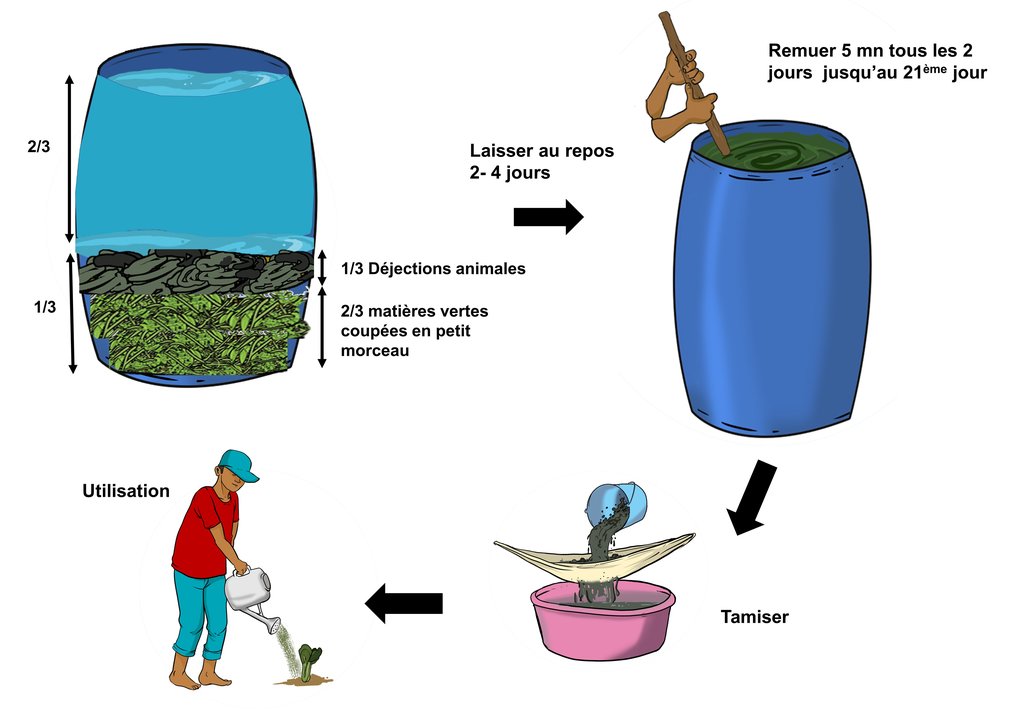Liquid Compost [Madagascar]
- Creation:
- Update:
- Compiler: Harifidy RAKOTO RATSIMBA
- Editors: Felana Nantenaina RAMALASON, Dimby RAHERINJATOVOARISON, Siagbé Golli, Tahiry Ravivonandrasana, Natacha Rabeary, Tabitha Nekesa, Ahmadou Gaye
- Reviewers: William Critchley, Rima Mekdaschi Studer
Zezika ranony, Compost ranony, compost liquide, ady gasy
technologies_6483 - Madagascar
View sections
Expand all Collapse all1. General information
1.2 Contact details of resource persons and institutions involved in the assessment and documentation of the Technology
Key resource person(s)
land user:
SOAVINJARA Josephine
Madagascar
land user:
RAJAONARIVELO (dit Dadajao)
Madagascar
land user:
ANJARAHANTANIRINA Vololoniaina Solange
Madagascar
land user:
FIADANA
Madagascar
land user:
HASINIRINA Zafimahatratra Jean de Dieu
Madagascar
Name of project which facilitated the documentation/ evaluation of the Technology (if relevant)
Soil protection and rehabilitation for food security (ProSo(i)l)Name of the institution(s) which facilitated the documentation/ evaluation of the Technology (if relevant)
Deutsche Gesellschaft für Internationale Zusammenarbeit (GIZ)1.3 Conditions regarding the use of data documented through WOCAT
The compiler and key resource person(s) accept the conditions regarding the use of data documented through WOCAT:
Yes
1.4 Declaration on sustainability of the described Technology
Is the Technology described here problematic with regard to land degradation, so that it cannot be declared a sustainable land management technology?
No
2. Description of the SLM Technology
2.1 Short description of the Technology
Definition of the Technology:
Liquid compost is produced by chopping and mixing animal dung and fresh plant matter, including plants with insect-repellent properties, in an aqueous medium. This liquid compost can be used as a substitute for mineral fertilizers and for pest control in crops. It can be used on all types of crops, but is particularly suitable for market gardening.
2.2 Detailed description of the Technology
Description:
Liquid compost is produced by chopping and mixing a blend of animal dung and fresh plant matter, including plants with insect-repellent properties, in an aqueous medium. Liquid compost can be used as a substitute for mineral fertilizers and for pest control in crops. It can be used on all types of crops but is particularly suitable for market gardening. Its application over large areas is problematic since the recommended application rates are high. This technique is therefore recommended for small plots, such as those used for market gardening. Various containers, including 20-litre plastic drums, 200-250-litre barrels, or 700-litre concrete tanks, can be used in making liquid compost.
The various steps involved in preparing liquid compost are as follows:
- fill two-thirds of the container with water
- finely chop the green matter, incorporating any repellent/biocidal plants (false neem, neem, tephrosia, comfrey, wormwood, tansy, chili pepper, etc.)
- gradually fill the remaining one third of the container with two parts of green matter and one part of animal manure
- cover the compost bin with a wooden or metal lid, but do not close tightly
- stir with a stick for five minutes, two days after mixing, then every two days until ready
- the process lasts about three weeks. The product must be sieved before use.
The recommended application rate is one litre of liquid compost per square metre, diluted to 50% strength. In market gardening, liquid compost is applied two weeks after transplanting or three weeks after seedling emergence. This product helps:
- improve soil fertility by enriching it with organic matter and promoting the life of living soil organisms
- protect crops against insect attack
On large plots, the application of liquid compost can be challenging due to the recommended application rate. Raw materials for compost production may be in short supply, and some farmers may find it difficult to obtain sufficient quantities of animal manure. In many cases, farmers opt to sell liquid compost by the litre.
2.3 Photos of the Technology
2.4 Videos of the Technology
Comments, short description:
https://www.youtube.com/watch?v=oKfj3rgt-cY
Location:
Ampitolova, Commune Belobaka, Région Boeny
2.5 Country/ region/ locations where the Technology has been applied and which are covered by this assessment
Country:
Madagascar
Region/ State/ Province:
Boeny
Further specification of location:
Manerinerina, Ambondromamy, Tsaramandroso, Belobaka
Specify the spread of the Technology:
- applied at specific points/ concentrated on a small area
Is/are the technology site(s) located in a permanently protected area?
No
Map
×2.6 Date of implementation
Indicate year of implementation:
2019
If precise year is not known, indicate approximate date:
- less than 10 years ago (recently)
2.7 Introduction of the Technology
Specify how the Technology was introduced:
- through projects/ external interventions
Comments (type of project, etc.):
GIZ Prosoil Madagascar
3. Classification of the SLM Technology
3.1 Main purpose(s) of the Technology
- improve production
- reduce, prevent, restore land degradation
3.2 Current land use type(s) where the Technology is applied
Land use mixed within the same land unit:
No

Cropland
- Annual cropping
Annual cropping - Specify crops:
- vegetables - leafy vegetables (salads, cabbage, spinach, other)
- vegetables - root vegetables (carrots, onions, beet, other)
- leafy vegetables, chillies, zucchinis, peas, peppers
Number of growing seasons per year:
- 3
Specify:
Some farmers manage 4 to 6 growth periods a year.
Is intercropping practiced?
Yes
If yes, specify which crops are intercropped:
carrots, beetroots, leafy vegetables, chillies, eggplants, peas, zucchinis, onions
Is crop rotation practiced?
Yes
If yes, specify:
carrots, beetroots, leafy vegetables, chillies, eggplants, peas, zucchinis, onions
3.3 Has land use changed due to the implementation of the Technology?
Has land use changed due to the implementation of the Technology?
- No (Continue with question 3.4)
Land use mixed within the same land unit:
No
3.4 Water supply
Water supply for the land on which the Technology is applied:
- mixed rainfed-irrigated
3.5 SLM group to which the Technology belongs
- integrated crop-livestock management
- integrated soil fertility management
- integrated pest and disease management (incl. organic agriculture)
3.6 SLM measures comprising the Technology

agronomic measures
- A2: Organic matter/ soil fertility
3.7 Main types of land degradation addressed by the Technology

soil erosion by water
- Wt: loss of topsoil/ surface erosion
3.8 Prevention, reduction, or restoration of land degradation
Specify the goal of the Technology with regard to land degradation:
- prevent land degradation
- reduce land degradation
4. Technical specifications, implementation activities, inputs, and costs
4.1 Technical drawing of the Technology
Technical specifications (related to technical drawing):
2/3 of the container should be filled with water, and the remaining 1/3 with animal manure and green organic matter. The should consist of 1/3 manure and 2/3 green matter, cut into small pieces to facilitate decomposition. After blending, the mixture should be allowed to rest for 2 to 4 days. It is then stirred for 5 minutes every 2 days until the 21st day, then sieved before use.
The container options include a 700 L concrete tank, a 200 L plastic container or a 20 L can.
Regardless of the container used, the same ingredient proportions must be adhered to consistently.
Author:
GIZ ProSoil Madagascar
Date:
02/23/2023
4.2 General information regarding the calculation of inputs and costs
Specify how costs and inputs were calculated:
- per Technology unit
Specify unit:
Volume of the liquid compost preparation container (litre)
Specify dimensions of unit (if relevant):
If employed as a biocide, 1 litre of liquid compost should be used for 1 acre of land, whereas if used as a fertilizer, 10 liters of liquid compost is sufficient for 2 acres.
other/ national currency (specify):
Ariary
If relevant, indicate exchange rate from USD to local currency (e.g. 1 USD = 79.9 Brazilian Real): 1 USD =:
4300.0
Indicate average wage cost of hired labour per day:
5000
4.3 Establishment activities
| Activity | Timing (season) | |
|---|---|---|
| 1. | Purchase of liquid composting containers and equipment | Before preparation (January) |
4.4 Costs and inputs needed for establishment
| Specify input | Unit | Quantity | Costs per Unit | Total costs per input | % of costs borne by land users | |
|---|---|---|---|---|---|---|
| Equipment | 200 L container | number | 4.0 | 200000.0 | 800000.0 | 75.0 |
| Equipment | Sieve | number | 1.0 | 6000.0 | 6000.0 | 100.0 |
| Equipment | Bucket | number | 4.0 | 12000.0 | 48000.0 | 75.0 |
| Equipment | Basin | number | 4.0 | 12000.0 | 48000.0 | 75.0 |
| Equipment | Watering can | number | 4.0 | 50000.0 | 200000.0 | 75.0 |
| Fertilizers and biocides | Manure | bag | ||||
| Total costs for establishment of the Technology | 1102000.0 | |||||
| Total costs for establishment of the Technology in USD | 256.28 | |||||
If land user bore less than 100% of costs, indicate who covered the remaining costs:
Each farmer was provided with the necessary equipment (1 watering can, 1 bowl, 1 bucket, etc.) by GIZ ProSoil.
Comments:
The availability of raw materials and containers continues to be a limiting factor for operators in the production of liquid compost. However, they can produce as much liquid compost as the supply of these raw materials and containers permits within a year
4.5 Maintenance/ recurrent activities
| Activity | Timing/ frequency | |
|---|---|---|
| 1. | Collect plant materials | All year round |
| 2. | Shred the green matter into fine pieces, adding any repellent/biocidal plants as necessary. | Dry season |
| 3. | Prepare the liquid compost | Dry season (from March), 21 days before use |
| 4. | Stir with a stick for 5 minutes | every 2 days from 2nd day of preparation until fully matured |
| 5. | Plant market garden crops | From March, April |
4.6 Costs and inputs needed for maintenance/ recurrent activities (per year)
| Specify input | Unit | Quantity | Costs per Unit | Total costs per input | % of costs borne by land users | |
|---|---|---|---|---|---|---|
| Labour | Chopping plant materials | man-day | 15.0 | 5000.0 | 75000.0 | 100.0 |
| Labour | Preparation of the liquid compost | man-day | 4.0 | 5000.0 | 20000.0 | 100.0 |
| Plant material | Pepper | kapoaka | ||||
| Fertilizers and biocides | Manure | kg | ||||
| Total costs for maintenance of the Technology | 95000.0 | |||||
| Total costs for maintenance of the Technology in USD | 22.09 | |||||
Comments:
The costs mentioned are associated with the production of 800 litres of liquid compost.
The cost of stirring the liquid compost is minimal, as it only requires labour for mixing the preparation for 5 minutes per day.
Kapoaka is a traditional Malagasy unit of measurement, equivalent to 300 ml.
The amount of manure may vary depending on its condition, but in this case, dry manure is used.
5. Natural and human environment
5.1 Climate
Annual rainfall
- < 250 mm
- 251-500 mm
- 501-750 mm
- 751-1,000 mm
- 1,001-1,500 mm
- 1,501-2,000 mm
- 2,001-3,000 mm
- 3,001-4,000 mm
- > 4,000 mm
Specify average annual rainfall (if known), in mm:
1400.00
Agro-climatic zone
- sub-humid
5.2 Topography
Slopes on average:
- flat (0-2%)
- gentle (3-5%)
- moderate (6-10%)
- rolling (11-15%)
- hilly (16-30%)
- steep (31-60%)
- very steep (>60%)
Landforms:
- plateau/plains
- ridges
- mountain slopes
- hill slopes
- footslopes
- valley floors
Altitudinal zone:
- 0-100 m a.s.l.
- 101-500 m a.s.l.
- 501-1,000 m a.s.l.
- 1,001-1,500 m a.s.l.
- 1,501-2,000 m a.s.l.
- 2,001-2,500 m a.s.l.
- 2,501-3,000 m a.s.l.
- 3,001-4,000 m a.s.l.
- > 4,000 m a.s.l.
Indicate if the Technology is specifically applied in:
- not relevant
5.3 Soils
Soil depth on average:
- very shallow (0-20 cm)
- shallow (21-50 cm)
- moderately deep (51-80 cm)
- deep (81-120 cm)
- very deep (> 120 cm)
Soil texture (topsoil):
- medium (loamy, silty)
Soil texture (> 20 cm below surface):
- medium (loamy, silty)
- fine/ heavy (clay)
Topsoil organic matter:
- medium (1-3%)
5.4 Water availability and quality
Ground water table:
< 5 m
Availability of surface water:
medium
Water quality (untreated):
for agricultural use only (irrigation)
Water quality refers to:
surface water
Is water salinity a problem?
No
Is flooding of the area occurring?
No
5.5 Biodiversity
Species diversity:
- medium
Habitat diversity:
- low
Comments and further specifications on biodiversity:
This region boasts a diverse array of plant and animal species, with some being native to the area. However, this biodiversity is relatively moderate when compared to other parts of the island. In terms of habitats, approximately 20% of the region comprises suitable environments for supporting this biodiversity, including forests, water bodies, mangroves, and more, though this percentage remains relatively low.
5.6 Characteristics of land users applying the Technology
Sedentary or nomadic:
- Sedentary
Market orientation of production system:
- mixed (subsistence/ commercial)
Off-farm income:
- less than 10% of all income
Relative level of wealth:
- poor
- average
Individuals or groups:
- individual/ household
- groups/ community
Level of mechanization:
- manual work
- animal traction
Gender:
- women
- men
Age of land users:
- youth
- middle-aged
5.7 Average area of land used by land users applying the Technology
- < 0.5 ha
- 0.5-1 ha
- 1-2 ha
- 2-5 ha
- 5-15 ha
- 15-50 ha
- 50-100 ha
- 100-500 ha
- 500-1,000 ha
- 1,000-10,000 ha
- > 10,000 ha
Is this considered small-, medium- or large-scale (referring to local context)?
- small-scale
- medium-scale
5.8 Land ownership, land use rights, and water use rights
Land ownership:
- individual, titled
Land use rights:
- leased
- individual
Water use rights:
- open access (unorganized)
Are land use rights based on a traditional legal system?
Yes
Specify:
Most villagers recognize the owners of agricultural fields in the village.
5.9 Access to services and infrastructure
health:
- poor
- moderate
- good
education:
- poor
- moderate
- good
technical assistance:
- poor
- moderate
- good
employment (e.g. off-farm):
- poor
- moderate
- good
markets:
- poor
- moderate
- good
energy:
- poor
- moderate
- good
roads and transport:
- poor
- moderate
- good
drinking water and sanitation:
- poor
- moderate
- good
financial services:
- poor
- moderate
- good
6. Impacts and concluding statements
6.1 On-site impacts the Technology has shown
Socio-economic impacts
Production
crop production
Comments/ specify:
Production increased 3 times more than before the application of liquid manure
crop quality
Comments/ specify:
Leafy vegetables can be stay fresh longer (up to three days) using liquid compost.
Water availability and quality
irrigation water availability
irrigation water quality
Income and costs
expenses on agricultural inputs
farm income
workload
Socio-cultural impacts
food security/ self-sufficiency
Ecological impacts
Soil
soil moisture
soil cover
Specify assessment of on-site impacts (measurements):
These are estimates from the farmers.
6.2 Off-site impacts the Technology has shown
Specify assessment of off-site impacts (measurements):
Not relevant
6.3 Exposure and sensitivity of the Technology to gradual climate change and climate-related extremes/ disasters (as perceived by land users)
Gradual climate change
Gradual climate change
| Season | increase or decrease | How does the Technology cope with it? | |
|---|---|---|---|
| annual rainfall | decrease | not well |
6.4 Cost-benefit analysis
How do the benefits compare with the establishment costs (from land users’ perspective)?
Short-term returns:
positive
Long-term returns:
very positive
How do the benefits compare with the maintenance/ recurrent costs (from land users' perspective)?
Short-term returns:
positive
Long-term returns:
very positive
6.5 Adoption of the Technology
- single cases/ experimental
6.6 Adaptation
Has the Technology been modified recently to adapt to changing conditions?
No
6.7 Strengths/ advantages/ opportunities of the Technology
| Strengths/ advantages/ opportunities in the land user’s view |
|---|
| Reduced expenditure on agricultural inputs and fertilizers |
| Good product quality |
| Improved soil quality (increased fertility and moisture) |
| Strengths/ advantages/ opportunities in the compiler’s or other key resource person’s view |
|---|
| Liquid compost is already in the market in many parts of Madagascar. It is generally sold by the litre, and can be a source of income for the household making it. |
6.8 Weaknesses/ disadvantages/ risks of the Technology and ways of overcoming them
| Weaknesses/ disadvantages/ risks in the land user’s view | How can they be overcome? |
|---|---|
| Availability of green plant materials in the dry season. | Planting trees such as acacias to provide green matter all year round, and collecting or purchasing crop residues |
7. References and links
7.1 Methods/ sources of information
- field visits, field surveys
Five (5) sites visited
- interviews with land users
Five (5) persons interviewed
- compilation from reports and other existing documentation
GIZ Prosol Madagascar data sheet
When were the data compiled (in the field)?
31/01/2023
7.2 References to available publications
Title, author, year, ISBN:
Région Boeny, 2016, "Schéma Régional d’Aménagement du Territoire de la Région Boeny"/Boeny Region, 2016, "Land Use Planning Scheme for the Boeny Region".
Available from where? Costs?
Boeny Region Hotel
Title, author, year, ISBN:
GIZ ProSol Madagascar, 2022, "Livret des Paysans Relais"
Available from where? Costs?
GIZ ProSol Madagascar
Title, author, year, ISBN:
GIZ ProSol Madagascar, 2022, Poster "Compost liquide"
Available from where? Costs?
GIZ ProSol Madagascar
Title, author, year, ISBN:
GRET, 2015, "Pratiques agroécologiques et agroforestières en zone tropicale humide", Fiche N°9 Compost liquide
Available from where? Costs?
GRET, https://gret.org/publication/pratiques-agroecologiques-et-agroforestieres-en-zone-tropicale-humide/
7.3 Links to relevant online information
Title/ description:
MADAGASCAR: LES BIO-INTRANTS DU CEFFEL, UNE ALTERNATIVE EFFICACE POUR LES AGRICULTEURS DU GROUPE FIFATA
URL:
https://www.fert.fr/madagascar-les-bio-intrants-du-ceffel-une-alternative-ecologique-efficace-pour-les-agriculteurs-du-groupe-fifata/
Title/ description:
"Le compost liquide", site web de l’Université de Mahajanga
URL:
https://soatany.org/fiches-techniques/
Title/ description:
CEFFEL, 2018, Film pédagogique "Compost liquide"
URL:
https://www.youtube.com/watch?app=desktop&v=Qbxy7eJpNqI
Title/ description:
CEFFEL, 2018, Film pédagogique "Compost liquide"
URL:
https://www.youtube.com/watch?app=desktop&v=Qbxy7eJpNqI
Title/ description:
CEFFEL, 2018, Film pédagogique "Compost liquide"
URL:
https://www.youtube.com/watch?app=desktop&v=Qbxy7eJpNqI
Links and modules
Expand all Collapse allLinks
No links
Modules
No modules


